Article Provided By
Jeff Shook, President
Michigan Lighthouse Conservancy
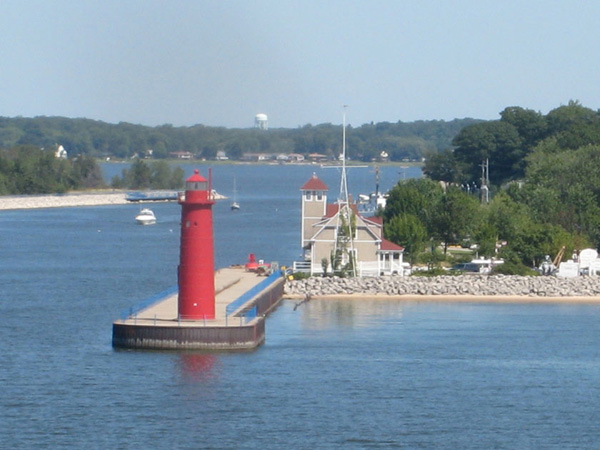
Early Lakeshore Community
Muskegon is a lakeshore community located on Michigan’s western shore just about directly across Lake Michigan from Milwaukee, WI and about one-third of the way up Michigan’s lower left hand from the Indiana State line. The towering sand dunes along the eastern shores of Lake Michigan collectively represent the world's largest accumulation of sand dunes bordering a body of fresh water.
Ottawa and Pottawatomi tribes
Lake Michigan is the sixth largest body of fresh water in the world and is the third largest of the Great Lakes. The Muskegon area was inhabited by various bands of the Ottawa and Pottawatomi tribes. The Ottawa Indians lived in the vicinity of Muskegon during the 1730’s and 1740’s until induced by the French to move their settlement. The name "Muskegon" is derived from the Ottawa Indian term ‘Masquigon’ meaning "marshy river or swamp." The "Masquigon" river is identified on French maps dating from the late seventeenth century, suggesting French explorers had reached the western coast of Michigan by that time.
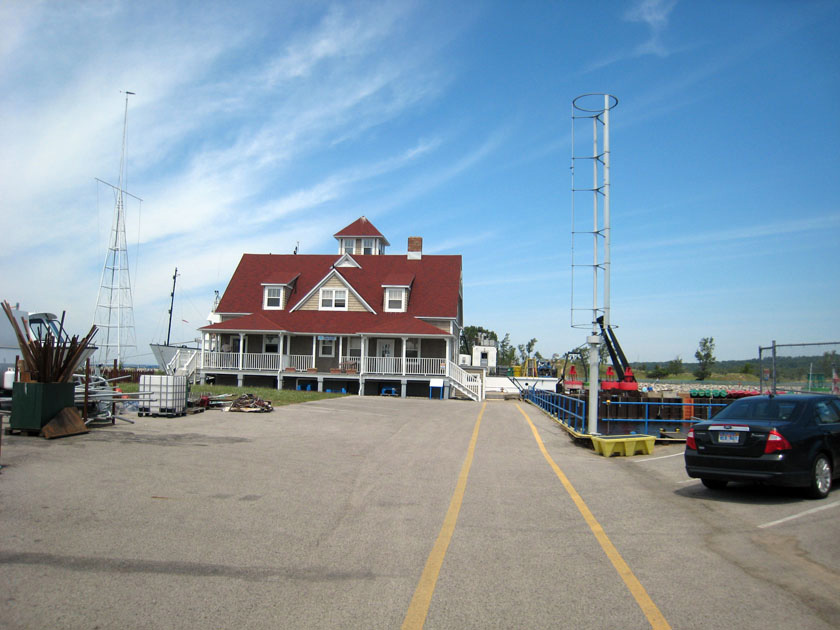
Early Settlement & Keepers
No one knows for certain when the first Frenchman visited the Muskegon area, but Father Jacques Marquette traveled northward through this area on his fateful trip to St. Ignace in 1675 and a party of French soldiers under La Salle’s lieutenant, Henry de Tonty, passed through this area in 1679. The City of Muskegon’s Pere Marquette Park is named in his honor. The earliest known resident of the county was a fur trader and trapper who visited the Muskegon area in 1748. Between 1810 and 1820, several French Canadian fur traders had established posts around Muskegon Lake. Settlement of Muskegon began in earnest in 1837 when Muskegon Township was organized as a subdivision of Ottawa County and the first sawmill began operating there. The lumber trade did not boom until after the Civil War.
This location went by another name for some time as noted in various Lighthouse Board reports and correspondence and this location at the mouth of Lake Muskegon was called Port Sherman, named by M.S. Burdge, who settled in the district in 1852 and by Samual A. Brown, who named it as such during the Civil War days when General Sherman was making his historic march to the sea. About 500 Indians inhabited the area near the mouth of the river in the 1850’s.
Apparently the need for a lighthouse was established early on, because in 1851 the first of many lighthouses was established here. Little is known about this first lighthouse as photographs have not been found yet, if they even exist. It was reported in the 1854 List of Lighthouses from a US Senate Document that the single keeper tended one light for a salary of $350 per year and the lighthouse was lit by six lamps, presumably Lewis Lamps. The first light keeper was Alexander Wilson who held the position for about one year and four months. Repairs were made to the lighthouse in 1854 as was very common for many lights as something always needed to be done with these structures exposed to the coastal environment and sometimes shoddy government construction contracts built by the low bidders.
The Lantern Room
For The Fiscal Year 1858 in the Report from the Secretary Treasurer, it was stated that the station consisted of the one lighthouse with the light on the keepers dwelling, no fog signal, was a fixed light visible for 10 miles. The tower was brick color and the base to the focal plane was 30 feet. The 1858 Lighthouse Inspection documents for the keepers residence listed the color of the dwelling as white and the lighthouse was made of wood. The lantern room was 8 sided and the dwelling was white with a shingle roof. It also lists the construction materials for the main structure as rubble stone with 5 rooms measuring overall 36 feet by 18 feet and was one and a half stories tall. The lighthouse was refitted in 1856 with a 6th Order Fresnel lens with an arc of 215 degrees coverage. By 1860 there were 13 mills operating in Muskegon and this area later became known as the “Lumber Queen of the World” by the 1880’s.
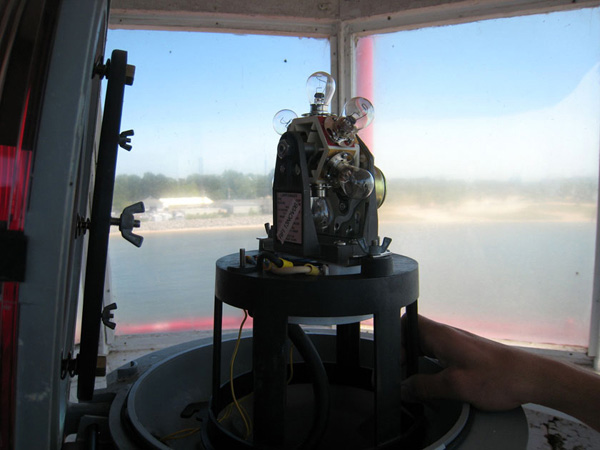
See Figure-1 for an example of a similar lighthouse plan dated 1857 that fits the time and description as close as possible to Muskegon’s. It is the authors best guess at what this original lighthouse looked like until other documentation is found. Similar plans were also built in other locations in Michigan.
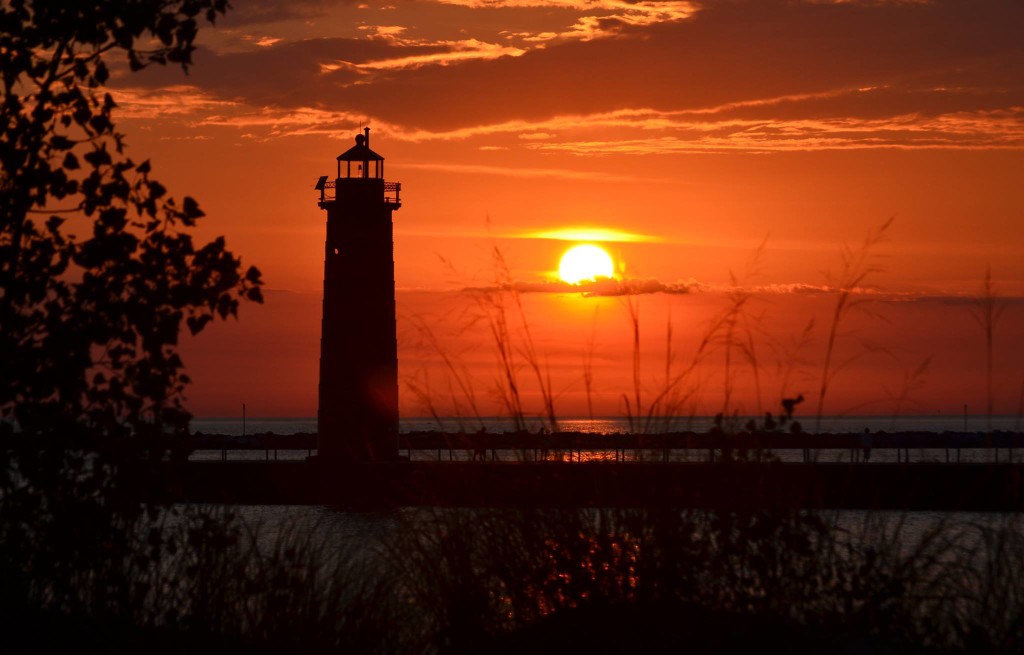
William Monroe
On September 23rd 1859, William Monroe assumed the position of Keeper. William passed away in 1862 and his wife took over as Keeper on November 20, 1862 and held that position until she resigned on May 5, 1871, making her Muskegon’s only female light keeper throughout their history. It is unknown as to why she left the position as Keeper, but she held the position for almost 10 years, a long tenure.
The Wooden Pierhead Beacon Light
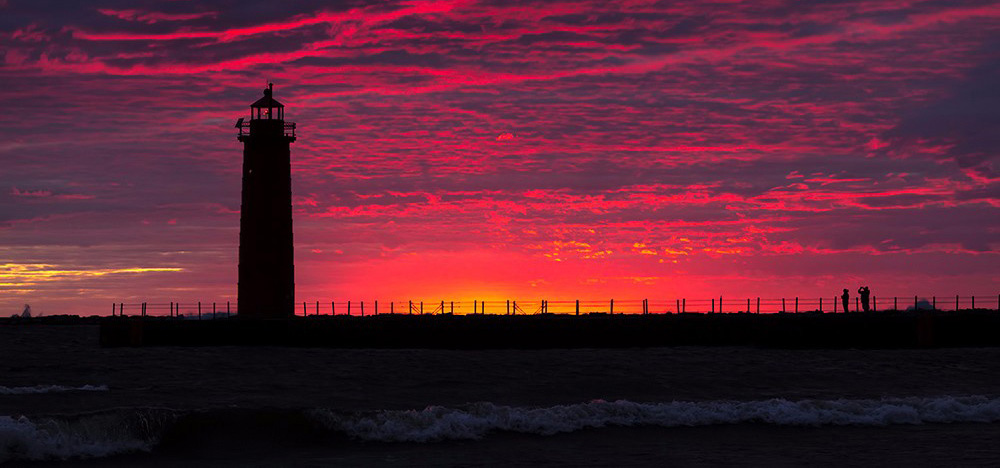
Figure-3 shows the Charlevoix beacon light, which was similar in construction to Muskegon’s beacon light.
The need for improvements was great and the local citizens took action in 1863 when the Muskegon Harbor Company was organized and they straightened the channel from Lake Michigan to Muskegon Lake by putting in slab piers. The north pier was 1,150 feet long and the south pier was 2,070 feet long. Early Muskegon was surrounded by lush hardwood forests and had direct access from Lake Michigan into Lake Muskegon, making it a natural port.
By 1867 more harbor improvements were needed and discussed. In 1870 Muskegon’s second lighthouse was built along with a new pierhead beacon light built in 1871, an elevated catwalk connected it to shore. We do not know if the original lighthouse was razed, but no photographic evidence has been found to suggest it existed after 1870. The 1870 light consisted of a one and a half story wood framed dwelling with a short square tower on the front side of the structure which rises above its gabled roof capped with a black lantern room. The photograph in Figure-2 shows the Muskegon 1870 structure. This lighthouse was similar in design to other lights such as Mission Point, Manistee and Mama Juda in Michigan. The 1870 lighthouse worked in conjunction with the pierhead light after it was established to form a range into the harbor. A lot of piers had auxiliary lights of various designs to help guide mariners through the piers and into the ports or harbors.
The wooden pierhead beacon light was constructed at the outer end of the south pier and was illuminated by a 6th Order lens, showing a fixed red characteristic. The light was shown 36 feet above the lake level. Unfortunately no photographs have been located of this beacon light, but an undated postcard shows the light after further improvements were made and the piers extended at a later date.
Construction of U.s. Life - Saving Service Station
In 1878, several more changes were noted for the harbor entrance. The construction of a US Life-Saving Service station began that would be a Life-Boat Station, defined as being able to launch a heavy boat, known as a life-boat because of its self righting and self bailing capacity, directly into the water on a marine railway. The station was completed in 1879 and began operations on the north side of the channel, directly across from the 1870 lighthouse. A photograph of the station can be seen in Figure-4 from an undated photograph. Also in 1879, the south pier was extended 275 feet and the beacon light had to be relocated to the end of the pier. It is noted that a fog bell was also moved to the end of the pier with the lighthouse. Typically this fog bell was struck by mechanical means and the mechanism was located in the lighthouse, just below the lantern room. The fog bell machinery was weight driven and struck the fog bell at designated intervals. See Figure-5 which shows the Charlevoix pierhead beacon after the fog bell was installed, similar to Muskegon’s. In 1884 it was noted that the bell struck every 15 seconds and used a Steven’s striking apparatus. The elevated catwalk was removed from behind the old beacon lights location and then 175 feet of elevated catwalk was built new behind the beacon light.
Henry Warren
A book called The History of Muskegon County, Michigan in 1882 made mention that Henry Warren, who was appointed Keeper in 1871, kept the light and was appointed for his gallant and meritorious services in the Navy during the last war on the Ohio and Mississippi Rivers. He was a native of New England and has spent most of his life on the ocean as a sailor. He is respected by all who know him and attends to his duty punctually and satisfactory. Unfortunately for Mr. Warren, the Lighthouse Board didn’t apparently like his service and by 1886 they had him removed from his position.

See Figure-1 for an example of a similar lighthouse plan dated 1857 that fits the time and description as close as possible to Muskegon’s. It is the authors best guess at what this original lighthouse looked like until other documentation is found. Similar plans were also built in other locations in Michigan.
Muskegon Harbor Company & The Army Coprs
The 1885 Annual Report to the Lighthouse Board noted some interesting things. They were still calling the Muskegon pierhead lights location as Port Sherman, the original name for the port, and that the elevated catwalk was twice damaged during the year by vessels running into the pier. Repairs were made. At this time, the width between the piers was 190 feet and the channel was 15 feet deep. It is not noted what time of day or what the weather conditions in which this damage occurred, but it was common back then for this type of damage to happen here and at other locations more often then not.
The first efforts for the harbor and pier improvements were started in 1863 by the Muskegon Harbor Company, but the Army Corps of Engineers managed all of the harbor and pier improvements after 1867. A lot of times they contracted out the work and oversaw it. The Army Corps had their problems besides ships running into the piers. In 1885, a detached 250 foot wooden crib section of the north pier was placed in position, filled with stone, and decked over, a common practice of the time. This would widen the entrance from 185 feet to 300 feet.
One side effect of the construction of the detached section caused an eddy to form just in front of the old north pier, where a hole 35.5 feet deep had been excavated by the current. The end of the old pier had been undermined, and in consequence of having been struck by a vessel going in, was badly wrecked. It is thought that when the new north pier was carried further out, the trouble that was caused by the seas breaking about over its outer end and meeting those coming in through the gap in shore will to a certain extent cease, hopefully stopping the undermining of the pier.

Mr. Hiero B. Heir
In October of 1884, a contract was entered into with Mr. Hiero B. Heir, of Chicago, IL., to place two cribs, 50 feet long by 30 feet wide, on pile foundation, in extension of the detached north pier. The work was to have been completed by June 30, 1885; but by the date of June 8 the time for completion was extended by the Chief of Engineers to August 31, 1885. To complete the harbor in accordance with the present project it was estimated that $113,625 would be required. It was recommend that $100,000 of this amount be appropriated for the fiscal year ending June 30, 1887.
Annual Report of the Secretary of War
A summary of improvements to the Muskegon Harbor was compiled in the 1889 Annual Report of the Secretary of War for the Army Corps of Engineers as follows. Prior to improvement by the United States, slab-piers and revetments had been built at the outlet of Muskegon Lake and River into Lake Michigan, with the result of securing 13 feet of water between them, but a bar with 7 feet on it existed in front of the entrance, which as constructed was only 175 feet in width. The project of 1866 took the work to this stage, and with subsequent modifications in 1869, 1873, 1881, and 1884, sought to provide a navigable channel of such depth as could be obtained by extending the piers to 17 feet in the lake, and to widen the entrance to 300 feet. The amount expended to June 30, 1888, was $232,635.82. The north pier projects into the lake 1,050 feet and has 1,450 feet of shore revetment. The south pier projects 800 feet with some 1,500 feet of revetment. The piers generally are in good condition, though the old portion of the south pier for about 350 feet from shore should be sheet-piled to make it tight. The shore revetments of slabs are in bad condition, and quite permeable to sand and water, and must be sheet-piled their entire length. The end of the north pier proper is about 190 feet from the south pier, but the outer detached 400 feet of north pier leaves an entrance width of 300 feet; 131 feet can be carried through the channel.
During the past year the expenditures were $3,909.98, principally for materials to be used in repairs, and including $1,000 in part payment for a survey steamer for general use in the district. A contract was made for 5 of the remaining 8 cribs to be built on the south pier, and these are in course of construction. Repairs are also to be made to both piers and revetments adjacent to the shore-line. For the fiscal year ending June 30, 1891, the south pier should be completed by adding the remaining three cribs, costing $18,000. The 3,000 feet of shore revetments should be sheet-piled and repaired to pre-vent injury to the channel by the passage of sand through them, at a cost of $15,000. A dredging plant should be procured for the use of the adjacent works, and the Muskegon share of it, including two months' service, would be $8,600. With allowance for contingencies, the amount required for 1891 was $46,000. As you an tell by this summary, a lot of work and money was being expensed here to promote safe navigation and commerce.
Making Necessary Repairs in Late 1800s
In 1891 276 feet of elevated catwalk were rebuilt. A post for supporting a wire for operating a light shown from the post at the outer end of the south pier was placed midway between the beacon and the outer end of the pier, and an additional wire for operating the light was provided. Two iron brackets for supporting the operating wires were placed on the light and intermediate posts, and various minor repairs were made. The goal was to illuminate the end of the pierhead as the piers kept being extended, so small minor aids were added until it was time to move the beacon light.
This concept is similar to the light exhibited at the end of the Pentwater pierhead light as shown in Figure-7 as an example of how this was accomplished. On November 19th, 1891 the schooner Maggie Dall tore away five posts of the elevated catwalk near the beacon light during a gale and in 1892 they were repaired. Also for the fiscal year 1892, the fog bell at Muskegon was in operation 366 hours, indicating many hours of hazardous navigation the mariners had to deal with. Another mishap happened on October 28th, 1892 when the schooner Ralph Campbell, upon entering the harbor during a gale, ran into and broke the middle post supporting the wires on which the tubular lantern ran and damaged 14 posts and the hand railing of the elevated catwalk, the necessary repairs were made.
Lighting End of The Pier
The concept of lighting the end of the pier continued to be used because 580 more feet of conduit was constructed for running in and out the lantern that was exhibited at the end of the pier. On July 25th, 1894 the light was exhibited for the first time at the end of the new 580 feet. It was also noted in the Annual Report to the Lighthouse Board that on September 11th, 1894, a 6th Order Fresnel lens was installed to replace the 180 degree light formerly in use in the beacon light. The tubular lantern light was short lived as in January of 1895, the structure was pushed over by ice, so repairs were required once again, a common theme with this light station. So five piles were driven 100 feet to the westward of their former position, braced and decked with planks and a small lamp house was built at the foot of the post from which a light was suspended. Again the pier was lengthened to accommodate this. Figure-7 shows an example of a pierhead post lantern and lamp house similar to the one mentioned here on the Manistee West Pierhead in 1916.

Some text that could go here describing the photo.
The Wooden Pierhead Beacon Light
In 1899 just before the turn of the century, major changes were being planned for the Muskegon harbor and the navigational aids. Plans and specifications for fog-signal boilers and machinery and estimates of the cost for the reconstruction of the rear range light and the building of 750 running feet of elevated catwalk were made. The materials were ordered and delivered for the fog signal building. The boilers and machinery under contract were inspected and found to be satisfactory. The 10 inch steam fog signal whistles were also provided. The fog-signal building and upper course of the superstructure were framed and ready for shipping to Muskegon, the fog-signal was to be in operation by the end of summer. On September 15th, 1899 the red lantern light exhibited from the outer end of the elevated conduit was moved to the outer end of the pier and shown from the gabled end of the fog-signal building erected there. On the same date, a 10 inch steam fog signal was established and the fog bell located at the rear light was discontinued. The fog bell was dismantled and shipped to Escanaba, where it was re-established on Sand Point in Little Bay de Noc along with the bell tower from the old Long Tail Point light station and was put into operation on May 1st, 1900.
An elevated conduit of 764 running feet was taken down and replaced by an elevated catwalk 720 feet long, 10 feet high, and 20 feet of walk 9 feet high passing through the open framework of the rear range tower and connecting it with the old walk, making a total of 740 running feet in all. The fog-signal building is a framed structure 20 feet by 40 feet, placed on a timber superstructure. In 1900 the 10 inch steam whistle, in duplicate was in operation about 176 hours and consumed 37 tons of coal and 2 cords of wood. Figure-8A shows the new fog signal building that was established in Muskegon at the outer end of the pier in 1912. Figure-8B shows the fog signal building in 1918.
The channel was a challenge to maintain because of silting and larger ships were being built that required a wider and deeper channel into the late 1800s. The original piers were gradually extended further and further out into Lake Michigan. Muskegon was proving to be a valuable port and prosperous one through the turn of the century.
In 1901 a fixed red light from a 6th Order Fresnel lens, visible for 8-1/2 miles, was installed in the front range light shown from the lantern room on the gable end of the brown, corrugated iron fog signal building. A 6th Order Fresnel lens was still installed in the beacon light, now the Muskegon Pierhead Rear Range Light and it was noted that improved 5th Order lamps were installed in both lights as well.
4th Order Fresnel Lens
In 1902, it was determined that the 4th Order lens on the keepers dwelling should be discontinued and it was to be re-established near the inner end of the south pier in a metal structure instead of the current wooden one. The current rear range red 6th Order lens on the pier would be discontinued. Detailed plans and specifications for the new metal tower were drawn up and bids sought and the contract was drawn up.
The contract for the metal tower was awarded and in 1903, the cast-iron metal work needed for the erection of a metal tower was completed and delivered to the supply depot in Milwaukee, soon to be transported to the light station. The structural steel and plate work under contract was completed and delivered to the site, the concrete foundation being ready to receive the structure.
The current 4th Order Fresnel lens located on the keepers dwelling will be transferred to this structure, near the inner end of the south pier, when the fixed red 6th Order lens on the pier, now the rear range light, can be discontinued. The cast iron octagonal lantern room from the 1870 lighthouse was removed completely from the dwelling and transferred to the new steel tower.
The Lighthouse Service was being very frugal with the money they were spending at this station by reusing parts. On September 27th, 1903 the tower was completed and the 4th Order lens exhibited a fixed white light there for the first time, the 6th Order lens was discontinued on the same date and the old wooden beacon light structure was removed. Some 350 feet of elevated catwalk was repaired to connect the new rear light to the front light and fog-signal. For the fiscal year 1904, the fog-signal was in operation some 511 hours, consumed 43 tons of coal and 3 chords of wood.
The Door County Advocate
The new rear range metal tower was erected to a height of 48 feet and then the lantern room added on top of that. The tower was painted white and an elevated catwalk connected it to the light and fog signal at the end of the pier. The lantern room was painted black. The rear range light kept this daymark characteristic until 1917 when both the front and rear range lights were changed in color to all red. Figure-9 shows the completed 1903 Muskegon Rear Range Light.
The Door County Advocate on January 7th, 1905 reported that a big blow swept over Lake Michigan last week and moved the Muskegon Life-Saving Station from its foundation and so badly wrecked the structure that it will have to be torn down. The fog-signal on the south pier was also badly damaged. Storm damages were estimated to be $500,000 from St. Joseph to Muskegon. In 1905 a new Life-Saving Station was built on the south side of the channel and it has remained there to this day and now serves as the NOAA Lake Michigan Field Station. Figure-10 Shows the new 1905 US Life-Saving Station on the south side of the channel.
January 20, 1915
On January 20, 1915 a light on the north pier was established to make the channel entrance. The light was mounted on a black skeletal tower on a concrete base, 41 feet above the water and shown a flashing white light every 3 seconds of 120 candlepower. Figure-11 shows this light in an undated photograph. On April 15th, 1917 the north pierhead light changed color to white. On that same date, both the front and rear range lights and the Muskegon Lake Light were all changed in color to red daymarks shown in Figure-12. On May 29, 1917, the pierhead rear range light was changed to fixed red and was 150 candlepower.

Some text that could go here describing the photo.

Figure-13A shows a photo of the dwelling and Figure-13B shows a close up of its position in relation to the 1905 US Life-Saving Station.
Keepers Dwelling
Along with these changes and additions to the light station, we know a new keepers dwelling was built. As more equipment was added to the station and the number of keepers increased, leaving the old 1870 dwelling too cramped on space.
Although I have yet to determine the exact date of its construction, anyone with information on it should please contact me.
We also don’t know if the 1870 keepers dwelling existed past the time of the construction of the 1905 Life-Saving Station either as we assume it would have been built close to the river mouth, not leaving much space for the Life-Saving Station and was probably razed.
The keepers dwelling to replace the 1870 one was originally constructed several hundred feet behind and slightly to the south the of the 1905 Life-Saving Station as evidenced in Figure 13B showing its relation to the Life-Saving Station in the close up view. The keepers dwelling housed a total of five keepers, head keeper and one through four assistants. The earliest photograph we have of the dwelling has a date of 1913 on it. We can make the assumption that the 1870 dwelling was razed to make way for the 1905 Life-Saving Station in that same year, but we have no proof at this time and more research needs to be done on the third keepers dwelling. From the photographic evidence it appears the dwelling was located at the end of a road based on the houses to the south as well as telephone poles and walkways in the photos. One shows railroad tracks and the other photo does not. From a US Coast Guard plot plan of the area dated 8-20-1981 is shows a US Lighthouse Service parcel located on the current day Beach Road where it turns into Fulton Drive. This was the original location of the third keepers dwelling.
October 28, 1919
As reported in a Lighthouse Service Bulletin in December 1919, early on the morning of October 28, 1919, the steamer Muskegon in endeavoring to enter the harbor of Muskegon struck the south breakwater and in less than 15 minutes had practically gone to pieces. Ransom Jakubovsky, 1st assistant keeper was on duty at the time the vessel struck, he immediately sounded distress signals with the fog signal and then went to the wreck, where he was assisted, by the aid of an electric flashlight, the passengers and the crew to the lighthouse safely on the pier. He directed the rescued to the fog-signal house for safety because of the high sea that was running, it was to dangerous to attempt to reach the shore over the breakwater and Mr. Jakubovsky himself was knocked over a number of times by the waves while engaged in the rescue effort. A few of the rescued, however, made their way to shore over the elevated walk on the breakwater, while the others remained and were cared for in the fog-signal house until daylight, when they too walked to shore and were there cared for by the residents in the vicinity. Upon his return to shore, Mr. Jakubovsky also assisted in the recovery of the dead. Thomas Robinson, head keeper of the Muskegon Light Station also aided in caring for the rescued passengers and the crew and in recovering the dead, and both he and Mr. Jakubovsky were commended by the Department of Commerce for their valuable assistance in this disaster.
Existing Changes as of 1921
The second-to-last major change to the channel started in the 1920’s when the arrowhead breakwater construction project began. This project was largely completed in the early 1930’s. During this project, the outer light and fog signal were dismantled, the south breakwater was shortened and the 1931 South Breakwater Light was established. The South Pierhead was dismantled to its current length today, leaving the 1903 light in its original location and the elevated catwalk dismantled because it was no longer needed.
The following is a summary of changes and existing conditions as of 1921. A flashing white light, 41 feet above water, visible 10 miles, is shown from a white skeleton tower on the outer end of the north pier. A fixed red light, 21 feet above the water, visible 6 miles, is shown from the inner end of the south pier. A red flashing light, 24 feet above water, visible 6 miles, is shown from a black, square, pyramidal tower in 9 feet of water on point of the shoal extending from the north shore of Muskegon Lake. This light marks the turning point in the lake. Range Lights – Front – a fixed red light, 31 feet above the water, visible 9 miles, is shown from the gable end of the fog-signal building on the outer end of the south pier. The fog signal is made with a steam whistle. Rear Range – a fixed red light, 50 feet above water, visible 14 miles, is shown from a red, conical tower 331 yards 60° (NE by E 1/8 E) from the front light. These lights form a range showing the direction of the entrance.
Completion of South Breakwater
Further work was accomplished with the harbor in 1928 consisting of the placing of a caisson at end of breakwater for the new South Breakwater lighthouse structure, the work having been carried on in conjunction with the U. S. Engineer Department. At the opening of the 1929 season the superstructure of the light station will be erected and a modern air fog signal and electric lighting will be provided. Due to the improvement in piers and the breakwater at Muskegon; Muskegon South Breakwater Light was established. To temporarily mark the breakwater construction work, a gas lighted buoy was established. Figure-14 shows the South Breakwater of the arrowhead harbor being constructed and the South Breakwater Light Structure under construction.
In 1930, according to the Lake Carriers Association Annual Report for 1930 and the US Lighthouse Service Annual Report, the temporary lighting at Muskegon Harbor was discontinued and new, improved aids established to accord with the extensive improvements made at the station. The Muskegon Rear Range Light and Muskegon Breakwater Light were illuminated with electricity and an air oscillator fog signal was installed. This date contradicts the National Register nomination form date of the South Breakwater Light being lit for the first time in 1931. Figure-15 shows the completed arrowhead harbor from an undated photograph.
A new transmitter and antenna were installed and the radio beacon and fog-signal synchronized for distance finding in 1939. The inner end of the North pier was provided with a skeleton wood structure fitted with reflectors in 1940. The structure and reflectors are flood-lighted by a lighting unit mounted on the opposite side of the channel.
As the Lighthouse Service was merged in with the US Coast Guard in 1939, the annual reports tapered off and information gathering is harder to research as more newspapers and other sources must be used to gather more information. So from this date forward there are a few notable things to write about.
Solving a mystery
One mystery we are trying to solve is finding out when the keepers dwelling was moved from its original location at Beach Street and Fulton Drive up next to the 1905 Life-Saving Station. Photographic evidence to date says that in 1929 it was in its original location and in 1955 it was next to the Life-Saving Station. If anyone has any information on when this happened or photographs of the building being moved, we would appreciate hearing from you. Figure-16 shows the keepers dwelling moved next to the Life-Saving Station dated 1955.

Some text that could go here describing the photo.

Figure-13A shows a photo of the dwelling and Figure-13B shows a close up of its position in relation to the 1905 US Life-Saving Station.
NOAA
The US Coast Guard abandoned their 1905 US Life-Saving Station in 1990 when the Coast Guard built a new facility and turned over the old building to NOAA. The turn of the century light keepers dwelling continued to survive until sometime between 1970 and 1972 when aerial photographs indicate it was razed to make way for Coast Guard expansion. The 1905 Life-Saving Station is currently being used by NOAA who has renovated the building for their use. The NOAA Lake Michigan Field Station is the oldest NOAA owned facility. Its architecture is known as a Racine-Type Station. NOAA funded the renovations in 2004 and completed them in 2005 on the stations 100th birthday.
November 17, 2005
On November 17, 2005 the South Pierhead Light’s contribution to Great Lakes navigation was recognized with a listing on the National Register of Historic Places. In 2006, the South Breakwater Light followed suit. In June of 2008, the Muskegon South Pierhead and South Breakwater Lighthouses, deemed excess by the Coast Guard, were offered at no cost to eligible entities, including federal, state and local agencies, non-profit corporations, educational agencies, or community development organizations. On June 17, 2010, it was announced that Michigan Lighthouse Conservancy, a lighthouse and Life-Saving Service preservation group, was the new owner of the South Pierhead Light and the South Breakwater Light.
Help Save Lighthouses – Donate Now
Help support the Michigan Lighthouse Conservancy with your thoughtful donation
